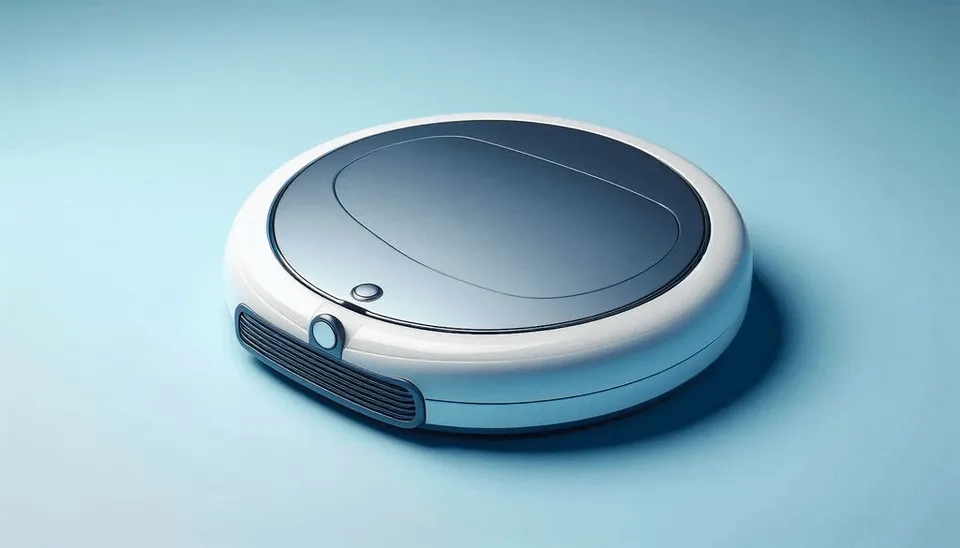
A robotic pool cleaner saves time and effort by automatically cleaning the pool, ensuring thorough cleaning, and often using less energy than manual methods. It can also improve water circulation and reduce the need for chemicals, making pool maintenance easier and more efficient. Robotic pool cleaners are small, wheeled machines that crawl along the surface of the pool and automatically clean it. They are composed of a small electric motor and a catchment for the debris. The motor creates suction to remove the dirt and debris, as well as allowing the machine to crawl up the walls. Reading this buying guideline will guide you through the realm of robotic pool vacuum cleaners.
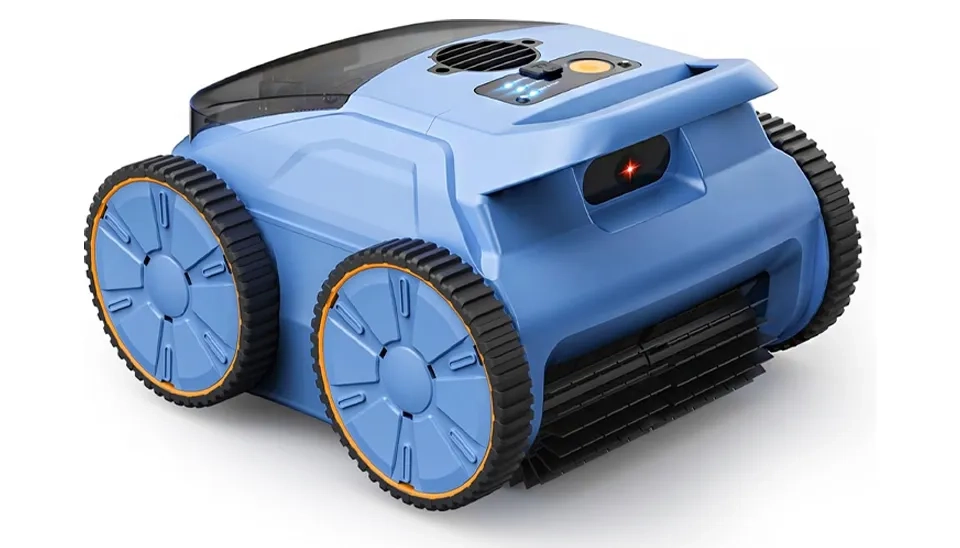
1. Key Considerations When Choosing a Robotic Pool Vacuum Cleaner
When buying robotic pool vacuum cleaners, there are several key factors to consider in order to choose the best option. This section of the buying guide highlights the main factors that will help in selecting the right robotic pool vacuum cleaner.
1.1. Purpose and Application
When purchasing robotic pool vacuum cleaners, it is essential to understand their purpose first. They can be used for many applications and objectives. First and foremost of the robotic pool vacuum cleaners goal is to remove debris from hard-to-reach areas. They can eliminate leaves, twigs, dirt, and sand from the pool. Using them frequently ensures that all debris will be removed, avoiding a mess in the pools. Therefore, by removing debris continuously, you can have clean water. Moreover, debris can clog the pool’s filtration system and reduce its performance. Therefore by using robotic pool vacuum cleaners, an appropriate filtration system can be guaranteed. In addition, algae and organic material can cause stains, corrosion, and damage to the pool system in the long term. Therefore, robotic pool vacuum cleaners can remove these organic materials and span the pool's lifetime and prevent costly damages. The last purpose that robotic pool vacuum cleaners are used is maintaining the aesthetic appeal of the pool, by removing debris from the surface and ground of the pool and making it enjoyable. Pools are playing a significant role in the aesthetic appeal of the house, and a clean pool and its surroundings make relaxation or socializing more pleasant.
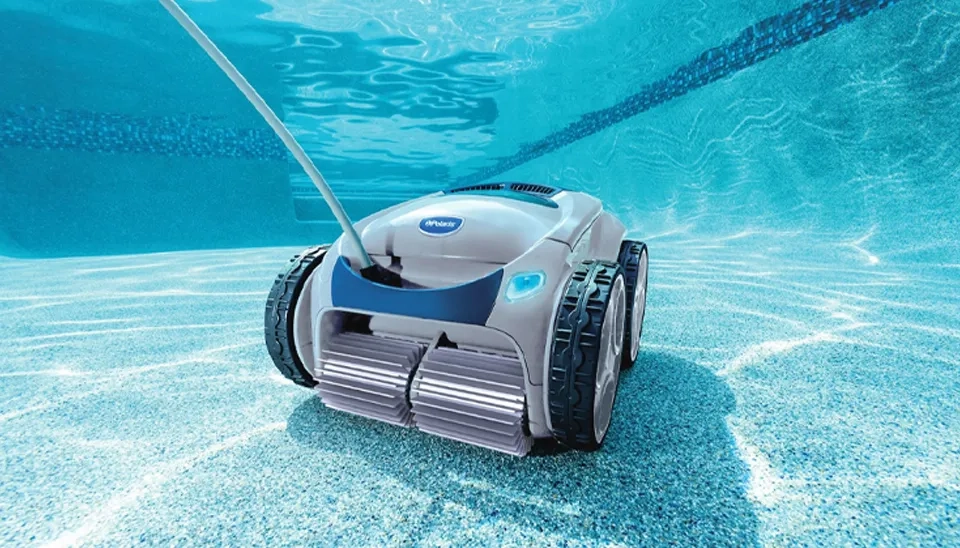
1.2. Consider Types of Robotic Pool Vacuum Cleaners Before Buying
In this section of the buying guide, we assessed different types of robotic pool vacuum cleaners. Robotic pool vacuum cleaners are gaining popularity among people due to their speed and efficiency. They have many types, each with its specific features and applications.
1.2.1. Basic Robotic Pool Vacuum Cleaners
The basic models have rudimentary functionality and fewer cleaning features that can clean the floor or walls of the pools. The models have basic navigation systems and simple systems for debris filtration. Also, they are affordable, lightweight and easy to use. They are more suitable for small pools, where the area of the cleaning is small. Basic robotic pool vacuum cleaners have easy operation, lower cost, but they have limited cleaning ability and are not suitable for cleaning hard-to-reach areas of the pools, such as corners.
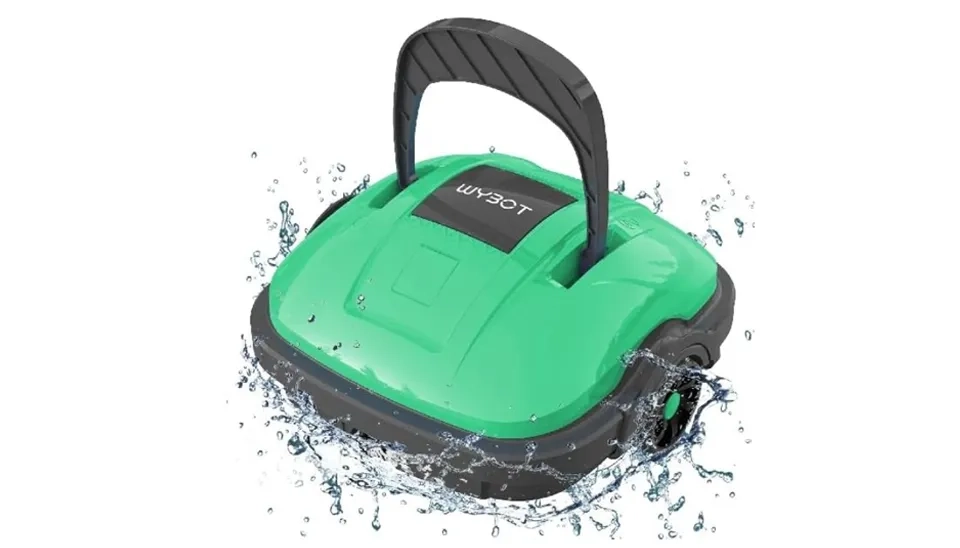
1.2.2. Advanced Robotic Pool Vacuum Cleaners
The advanced models offer more robust cleaning with better suction and an advanced navigation system, allowing for cleaning pools’ corners. They generally come with advanced sensors to identify obstacles for better navigation, leading to more efficient cleaning. Advanced models can be used for both floors and walls with intricate shapes. They offer multi-filtration systems for trapping finer debris and organic materials. They might incorporate simple programming for scheduling navigation.
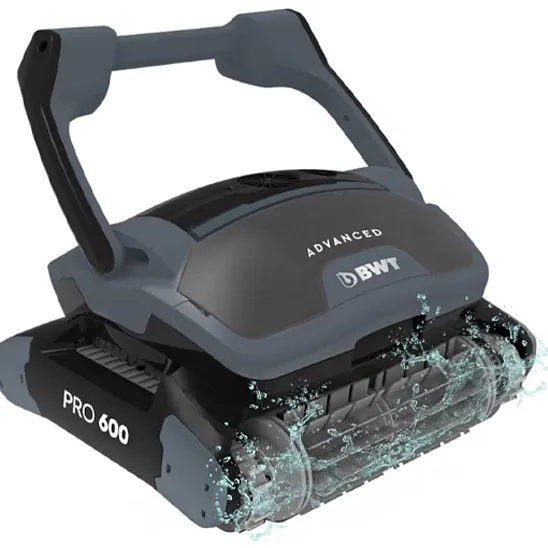
1.2.3. Smart Robotic Pool Vacuum Cleaners
The smart robotic pool vacuum cleaners have various sensors, are remote-controlled and Wi-Fi enabled, with the ability to connect to smartphones or apps for better control. They can schedule operations from anywhere. This is useful when you are out of home and want to clean your pool. These smart cleaners can gather real-time data and export it for future comparison. Some models can integrate with smart imaging systems in your house, such as Alexa or Google Assistant. These models are ideal for big pools and people who want to have full control over the cleaning process. However, smart robotic pool vacuum cleaners are more expensive and need a stable Wi-Fi connection.

1.3. Choose the Best Technology of Robotic Pool Vacuum Cleaner
Robotic pool vacuum cleaners come with various technologies to ensure cleaning efficiency. These technologies can increase user convenience, resulting in more efficient performance.
1.3.1. Turbine and Pump Technology
Robotic pool vacuum cleaners use a turbine or pump to suction dirt, debris, and organic material. For example, pressure side cleaners use water pressure from the pool’s return jets to move and eliminate impurities. They are less dependent on the internal batteries, offering a greater cleaning range. Another technology is an internal pump that traps dirt and debris in the vacuum’s filtration system. They have a filtration bag or cartridge to collect debris. Cleaners with this technology are better for pools with fine impurities like dust or sand, but might have limited functionality with large debris such as leaves or twigs. Some models integrate both technologies, which makes them ideal for both coarse and fine debris. The following section will address the key advantages of these technologies.
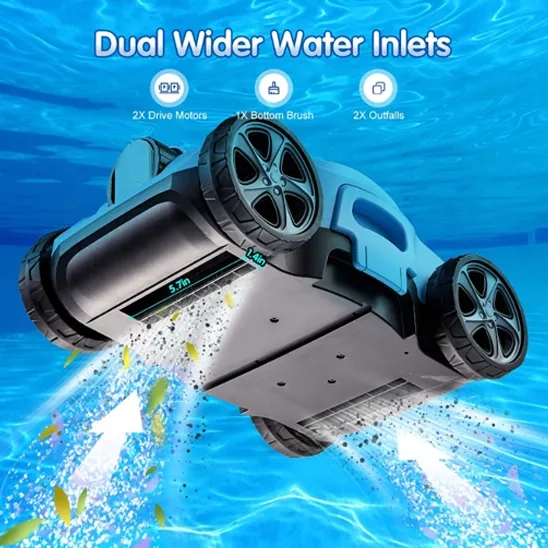
1.3.2. Brush Technologies
Robotic pool vacuum cleaners can have rotating brushes or scrubbing brushes. Rotating brushes have one or more brushes that rotate circulatory, which typically are made of nylon, rubber, or plastic bristles. The rotating function is particularly useful for debris that are stuck to the pools’ walls, floors, and waterlines. They are more suitable for cleaning smooth surfaces. On the other hand, scrubbing brushes are fixed with only movement back and forth to scrub surfaces. They can eliminate dirt, stains, and algae buildup. Robotic pool vacuum cleaners with scrubbing brushes are more suitable for walls or water lines, where they are prone to algae accumulation. Advanced models use both rotating and scrubbing brushes to ensure maximum cleaning.
1.3.3. Power Source
Robotic pool vacuum cleaners can use a battery, a direct electricity connection, or both as a power source.
1.3.3.1 Battery-Based Power
Battery-powered robotic pool vacuum cleaners are becoming increasingly popular due to their lightweight design, ease of use, and convenience. These cleaners typically feature lithium-ion batteries, which offer a good balance between weight, charging time, and lifespan. Battery capacity is an important consideration, as it determines how long the cleaner can operate before needing a recharge. Models with higher capacity batteries tend to have longer cleaning times, but they may also increase the weight of the unit. Many battery-based cleaners also come equipped with automatic charging systems, where the robot returns to its charging dock once the battery is low, ensuring that it’s always ready for the next cleaning session without manual intervention. In terms of battery life, most robotic pool vacuums offer anywhere from 1.5 to 3 hours of continuous cleaning on a full charge, depending on the battery size and pool conditions. Some models may also allow users to replace or upgrade batteries for longer life and better performance. While battery-based cleaners are fully autonomous and ideal for pools without access to a power outlet, users should ensure that the battery’s charging time is suitable for their needs, as it may take several hours to fully recharge.
1.3.3.2 Cord-Based Power
Corded robotic pool vacuum cleaners are an affordable alternative, offering an unlimited power source since they are directly plugged into a power outlet. These cleaners do not have the limitations of battery life and can clean for as long as necessary. The main disadvantage of corded models is their restricted mobility due to the cord length, which may prevent them from reaching certain areas of the pool. Additionally, storing corded cleaners can be more challenging, as the cord needs to be managed and kept organized to prevent damage. However, for users with large pools or those who do not want to worry about battery life, corded robotic vacuums provide a continuous cleaning solution.
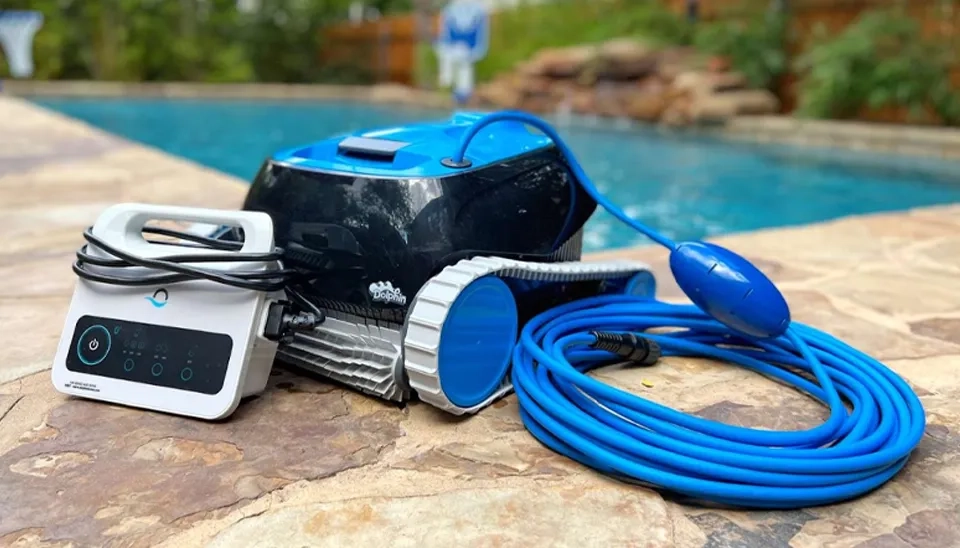
1.3.3.4 Hybrid Power
Hybrid robotic pool vacuum cleaners offer the best of both worlds by combining the advantages of both battery-powered and corded systems. These models can operate autonomously on battery power, giving them the freedom to navigate the pool without being tethered. However, if the battery runs low or if a longer cleaning session is required, the hybrid cleaner can be plugged into a power outlet, providing an unlimited power source. This dual functionality solves the problem of limited battery life while maintaining the flexibility of cordless operation. Hybrid models are perfect for users looking for a balance between convenience and uninterrupted cleaning performance.
1.3.4. Smart Features and Connectivity
Designed for hands-free operation, the automatic vacuum cleaner uses sensors, motors, and algorithms for intelligent navigation and cleaning. They map your home, clean based on your preset schedule, and return to their charging station when the battery is low or the job is done. Various robotic pool vacuum cleaners are smart and offer Wi-Fi and Bluetooth connectivity to connect to smartphones for updates and maintenance. On these devices, users can initiate and monitor the cleaning process in real time.
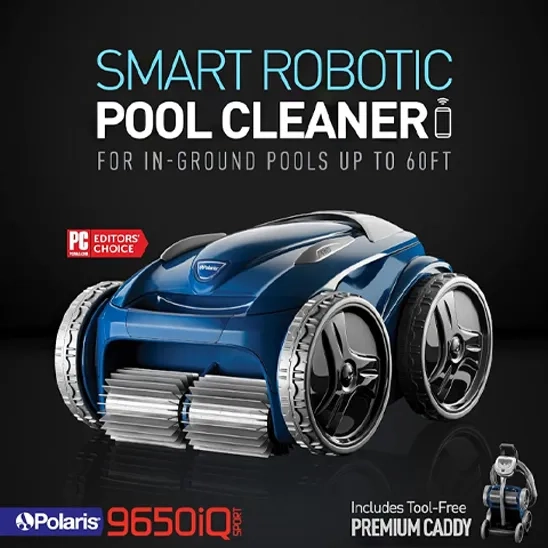
1.4. Climbing and Pool Wall Cleaning
For cleaning the entire pool, you need a robotic pool vacuum cleaner with the ability to clean the walls and water lines. This feature is made possible through a combination of powerful motors, superior traction, and advanced algorithms that guide the cleaner up vertical surfaces. Specifically, these robots are equipped with tracks or wheels that provide the necessary grip to climb walls and overcome the pull of gravity. To do the climbing, the cleaner's filtration bag must not be full. Also, when new or the unit has been out of the water for a long time, they harden and won't produce the traction needed to get up the wall.
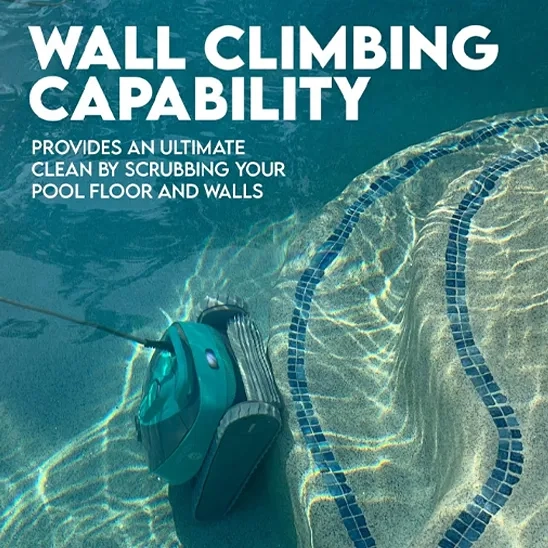
1.5. Size and Mobility
Robot pool vacuum cleaners come in a range of different sizes to fit different pool sizes and kinds. There are small, compact models that are appropriate for cleaning small pools, such as above-ground pools or pools with smaller surfaces. The small, compact models are designed to be compact and lightweight for ease of transport and storage. They work well in small spaces and pools that do not require extensive cleaning time. On the other hand, larger robotic pool cleaners are designed for bigger pools, such as in-ground pools or pools with large surfaces and complicated areas to clean. These models are more robust, with more suction power and larger brushes for deep cleaning. The majority of robotic pool vacuum cleaners are cordless, which greatly enhances their mobility. Without a cord to hold them back, the units can roam freely around the entire pool, reaching corners and edges that could be difficult for corded units to access. Cordless operation not only makes them better cleaners but also makes them safer and more convenient to use because there is no risk of tripping or becoming tangled in a cord.
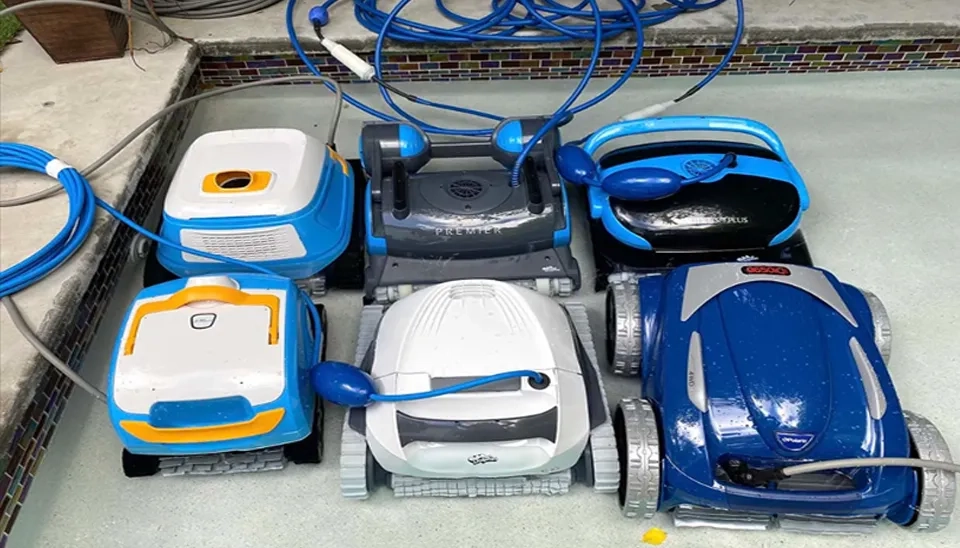
1.6. Cost and Budget
One of the important factors when buying a robotic pool vacuum cleaner is the price, which will be evaluated in this part of the buying guideline. The robotic pool vacuum cleaner has a wide range of prices, from basic and compact ones to smart and advanced models for larger pools. Not knowing which device is right for you might lead to loss of money. The basic models usually have a price range of $200 to $400, offering basic cleaning capabilities. For example, dual motors, dual suction ports, and dual brushes. However, they can generally only clean the flat floor. Another price range is $400 to $800 which middle range cleaners are in this class, offering improved suction power and filtration systems. Many of them incorporate wall climbing features with a large and in charge oversized debris cartridge.
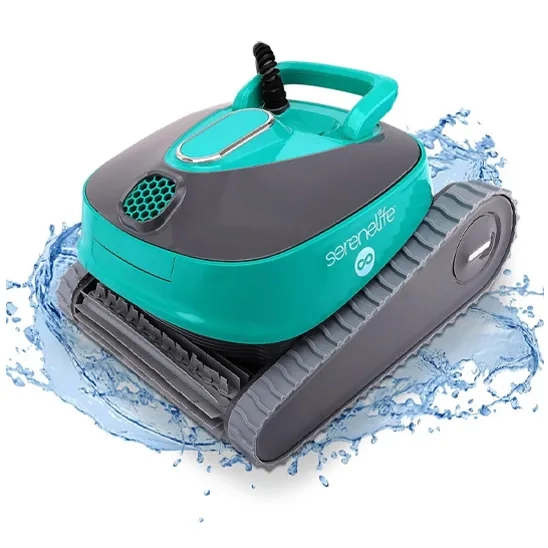
The last price range is $800 to higher than $1,500, which incorporates advanced and smart models. Modern robotic pool vacuum cleaners are incorporating Wi-Fi and Bluetooth connections for remote access and saving data. This is extremely helpful for more efficient cleaning. For example, the Polaris 9650iQ Sport Robotic Cleaner has a built-in WiFi connection that enables iAquaLink app control and is equipped with a 70ft cable with tangle-reducing swivel and an extra-large 5L debris canister. The 9650iQ Sport gets all the dirt and debris in the pool utilizing Vortex Vacuum technology that keeps debris suspended for long-lasting suction and superior cleaning performance. For more than 50 years, Polaris has been known worldwide for its quality and premium cleaning power. This visionary class of pool cleaners has become the benchmark against which all others are measured. Focused on premium engineering, rugged construction, and reliability, Polaris pool cleaners are built to last and are proven to clean where others can't.
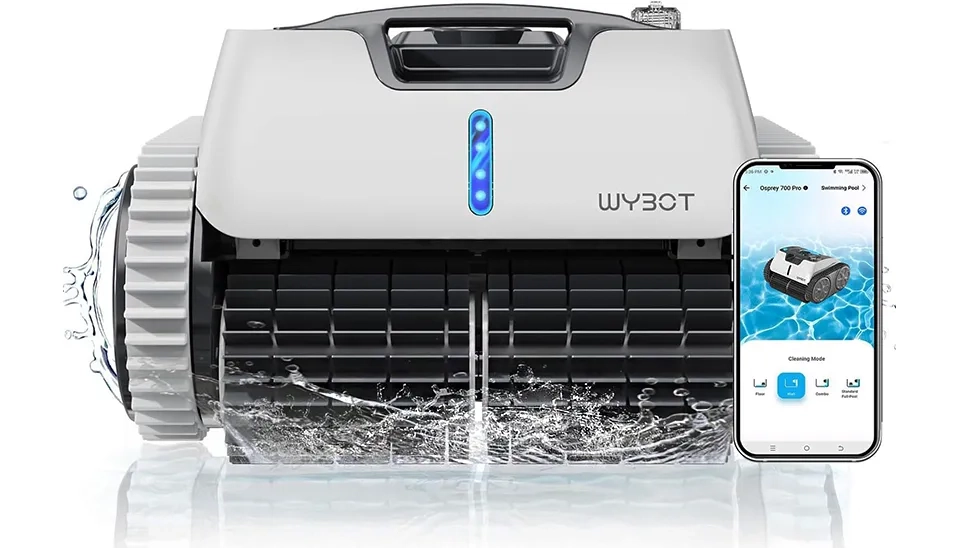
1.7. Customer Service
This section of the buying guide is devoted to customer service. It’s important to avoid purchasing a device that lacks ongoing support from the manufacturer, as you might encounter issues with usage or sensor malfunctions. Before buying robotic pool vacuum cleaners, customer service should assist users in selecting the right model based on their needs, pool type, and size. These devices often come with a variety of features that could be overwhelming, so customer service should be ready to explain the features and address any questions. While robotic pool vacuum cleaners are generally user-friendly and easy to set up, some users may face challenges with charging or Wi-Fi connectivity. Therefore, clear instructions should be provided to help users. A company with excellent customer service offers helpful resources like manuals, video tutorials, and troubleshooting guides on its website. For example, users may experience problems with the cleaner getting stuck, navigation errors, or weak suction power. A company with good support should clearly specify which issues and parts are covered under warranty to avoid confusion. Many brands offer warranties; for instance, WYBOT provides a 2-year warranty and a 30-day return period, giving ample time to assess the product's performance.
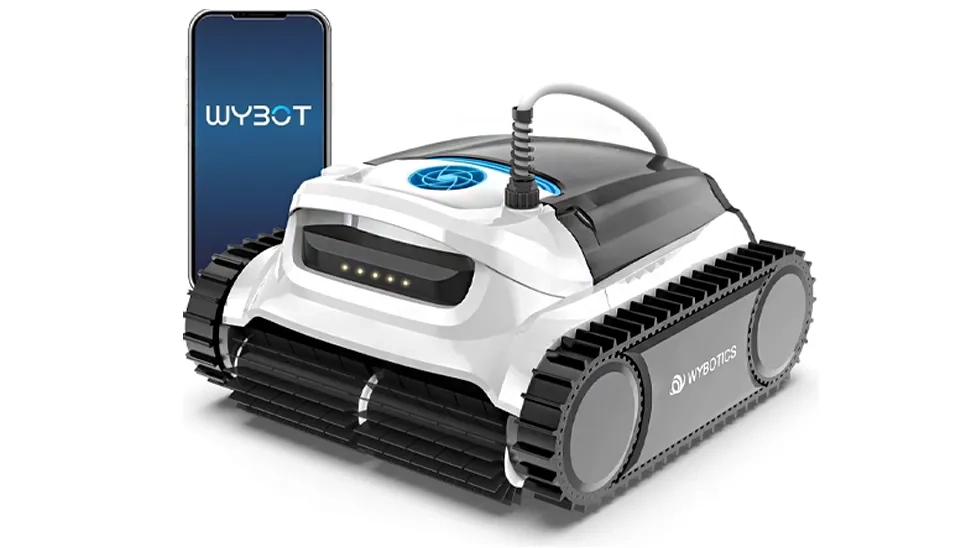
1.8. Materials and Durability
Material of the robotic pool vacuum cleaner plays a significant role in durability and the product’s life span. A variety of materials are used in robotic pool vacuum cleaners, such as ABS plastic, polycarbonate, PVC (Polyvinyl Chloride) , and aluminium alloy. ABS is usually used in the body, which is lightweight, durable, and impact-resistant. Polycarbonate can tolerate the sunlight; therefore, it is used for the parts that are exposed to UV and sunlight. Polyvinyl chloride is utilized in the parts where water resistance is needed. The main task of robotic pool vacuum cleaners relies on brushes, so their material is important. Most of them are made of nylon or polypropylene bristles that are durable and withstand chemical degradation. Rubber brushes can also be incorporated into the durable cleaners. Other parts that are important for navigation are tracks or wheels, which facilitate the movement of robotic pool vacuum cleaners. Most cleaners use rubberized tracks or wheels because it is easy to navigate and are chemical resistant. Another important component is filters, which can be made of polyester or pleated fabric.
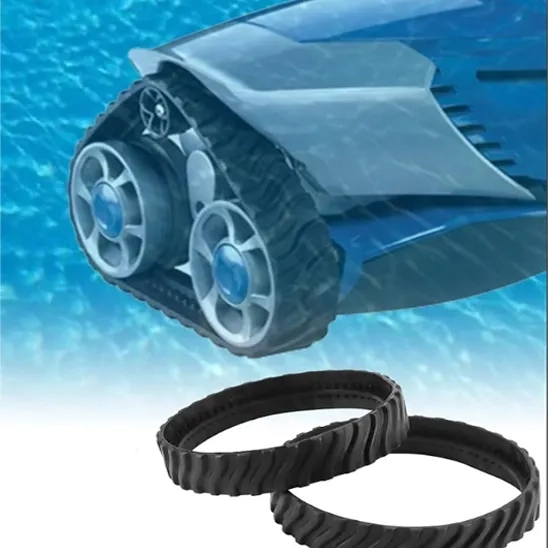
1.9. Filters
Filters are responsible for retaining debris, while robotic pool vacuum cleaners keep moving. One of the most common types is mesh filters, which are made of synthetic materials, such as polyester or nylon. They are more useful for eliminating large debris like leaves. They are easy to maintain; however, fine dust might cause clogging in these filter types. Another type is cartridge filters designed for capturing finer debris, like dirt. They are more difficult to clean, and after using them for a while, they need to be submerged in a cleaning solution to maintain their performance. However, cartridge filters have a larger capacity than mesh filters, requiring less frequent cleaning of the filters.
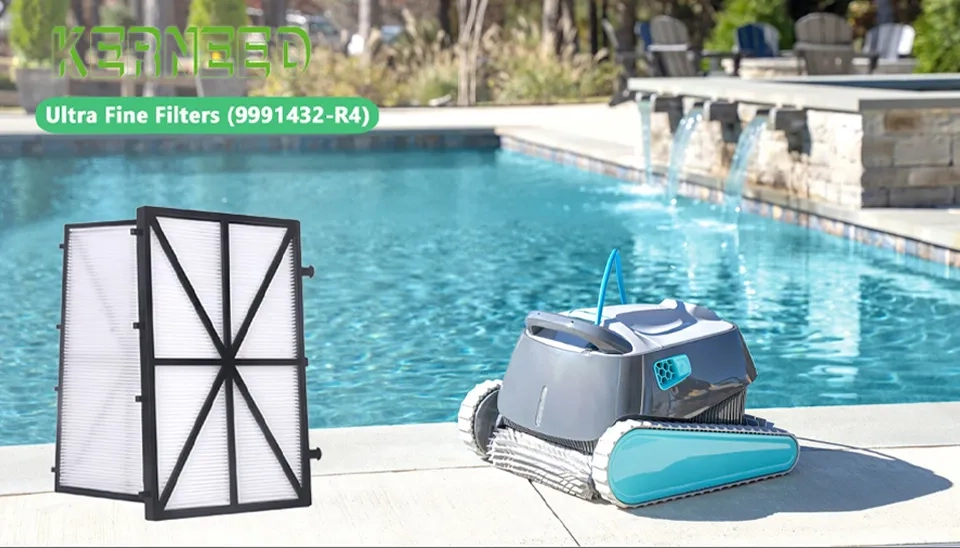
1.10. Product Ranking
To choose the best robotic pool vacuum cleaners, you must pay attention to all the information that we have mentioned in this buying guide. This helps you to make an informed decision. In addition, online platforms like Amazon can be useful, where you can read the reviews and comments. Most of the users make comments about the negative and positive features of the products, which can give you an overview of which product is better. Also, our article ‘Top 8 Robotic Pool Cleaners for Sparkling Above and In-Ground Pools‘ can be helpful, where we ranked the products by using Bayesian ranking rather than traditional methods. This method uses both the average rating and total reviews. In the article mentioned above, the Dolphin Nautilus CC Plus Robotic Pool Cleaner ranked first with powerful climbing capability to easily scrub your pool’s floor and walls. It is ideal for above/in-ground pools, and for all pool shapes with different surface types. This robotic pool cleaner is suitable for pools up to 50 feet in length. This product is equipped with a smart navigation technology, so the robot cleans by scanning the pool to determine the best path. It is lightweight, durable, and affordable.
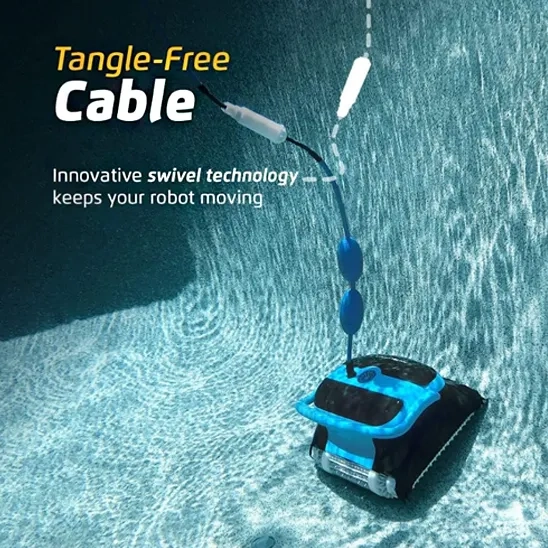
2. Comparing Different Types of Robotic Pool Vacuum Cleaners
This section of the buying guide compares different types of robotic pool vacuum cleaners, providing insights for a wiser choice. There are different types of robotic pool vacuum cleaners on the market that you can select based on your needs.
2.1. Chord-based / Battery-based Robotic Pool Vacuum Cleaners
In a larger categorization, they categorize whether wire-based or battery-powered. Generally, simple robotic pool vacuum cleaners are affordable and use direct electrical power with a cord to give them mobility. However, the cord can limit their range; therefore, they are better for small pools. Also, wiring makes them difficult to store. Robotic pool vacuum cleaners that use batteries instead of relying on power outlets have become popular recently. These cleaners are more efficient and have more manoeuvres that can reach all the pool’s area, wall,s and corners. Also, they are user- and environmentally friendly, offering consulting with much less power than cleaners with cords. As they are using batteries with limited energy, they use advanced navigation systems to conserve their power. In addition to the sensors to avoid obstacles and find the debris. These cleaners not only have better performance but also minimize the constant supervision of the users.
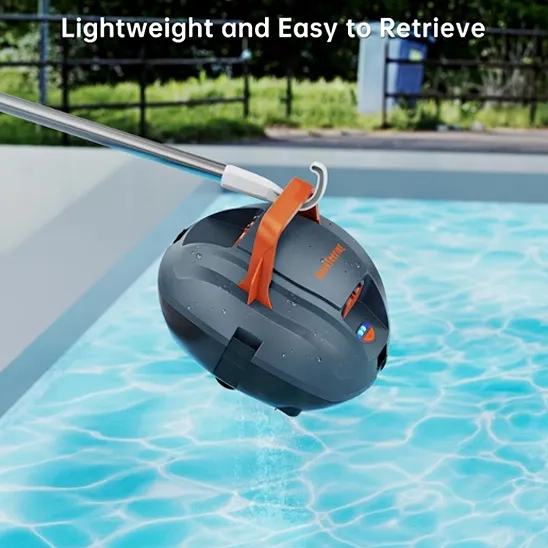
2.2. Floor / Wall Climbing Robotic Pool Vacuum Cleaners
Another category is whether the robotic pool vacuum cleaners are able to climb up the walls or are specific to the floor. This ability is a unique advantage that offers a full pool cleaning. These cleaners come with powerful motors, allowing them to move vertically. Models include the WYBOT C1 Cordless Robotic Pool Cleaners, which follow an N-shaped path for wall cleaning and an S-shaped path for pool floor cleaning, ensuring comprehensive coverage and optimal cleaning results. Equipped with an upgraded independent water pump motor, achieving a maximum filtration rate of 2642 GPH, dual PVC brushes with a strong grip, which can thoroughly and efficiently attack various debris, garbage like sands, leaves, and tough dirt from ALL pool surfaces. Ensuring a thoroughly clean and crystal-clear pool provides a refreshing swimming experience. On the other hand, cleaners with the ability to clean only the floors are more affordable, while their maintenance costs are lower. However, they are suitable when debris settles down on the floors.
2.2. Smart Robotic Pool Vacuum Cleaners
Robotic pool vacuum cleaners can be smart and offer Wi-Fi or Bluetooth connection, voice control, or app integration, offering scheduling and monitoring of the cleaning process. More advanced ones come with gyroscopes, accelerometers, and cameras to boost their performance. While the smart robotic pool vacuum cleaners offer customization on how and when to clean your pool, they need a constant Wi-Fi connection to maintain their performance.
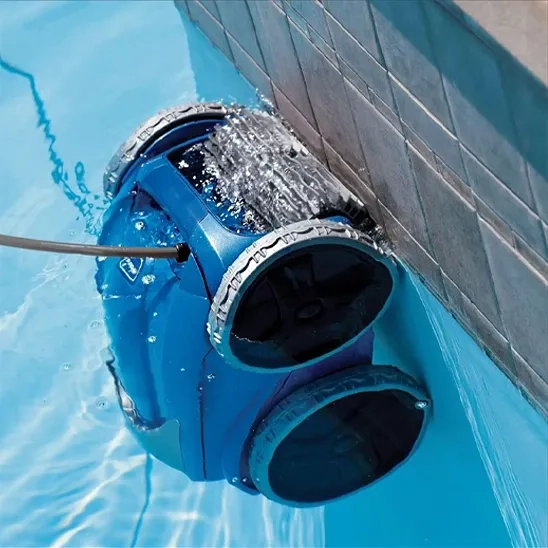
3. Assessing Your Specific Needs Before Purchase
Before purchasing an appropriate robotic pool vacuum cleaner, it is vital to evaluate your particular needs to select a device that adequately fulfils your requirements. This includes assessing your pool type and setting a reasonable budget. By following these steps, knowledgeable purchases that match your usage objective can be guaranteed.
3.1. Calculate Your Requirements
First and foremost, measure the length, width, and depth of your pool, because if it is too large, you need a more powerful robotic pool vacuum cleaner with a larger capacity. Also, the wire-based cleaners might not be a good option for larger pools. Next, calculate the pool’s volume (length × width × average depth). This will give you an initial assumption of how much debris you might encounter. In the description of most cleaners, it is specified how much volume they can handle. If you want a cord-based cleaner, make sure that the cleaner’s wire is long enough to reach the corners of your pool. Moreover, it is important to identify the pool material because each type requires a unique brush. For example, scorpion dirt and algae from pools made of tile are more difficult because debris can stick to them. Therefore, more intense scrubs with higher power are needed. While pools made of vinyl are prone to damage and need gentle scrubs and brushes. Another element is the pool’s shape, which can be determined. Moreover, rectangular pools are straightforward, but kidney-shaped pools are more difficult to clean, and you might need an advanced robotic pool vacuum cleaner with smart navigation. Also, pools with stairs, ledges, or sharp angles are difficult to clean for cleaners, so you need cleaners with the ability to clean the angles.
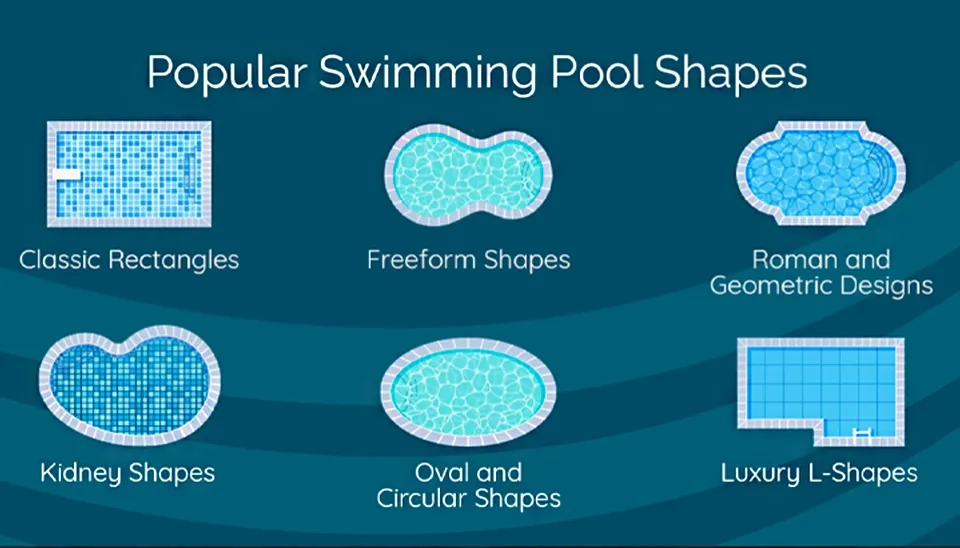
Another element to consider is the debris type and frequency. Debris can be categorized as fine or coarse. If your pool is under the tree with falling leaves, the main debris that you are struggling with is, of course. Therefore, select one that is compatible with this debris as well as has the largest debris capacity. On the other hand, if dirt and fine debris are prominent in your pools, cleaners with cartridges and more advanced filtration systems are needed. In addition, consider the cleaning cycle, which is the length of time that robotic pool vacuum cleaners take to clean the pool. While small pools ( lower than 10 meters) require 1 to 2 hours to clean, larger pools with intricate shapes need more than 2 hours to clean. Also, debris type can influence the cleaning cycle because larger debris might need more time to be cleaned.
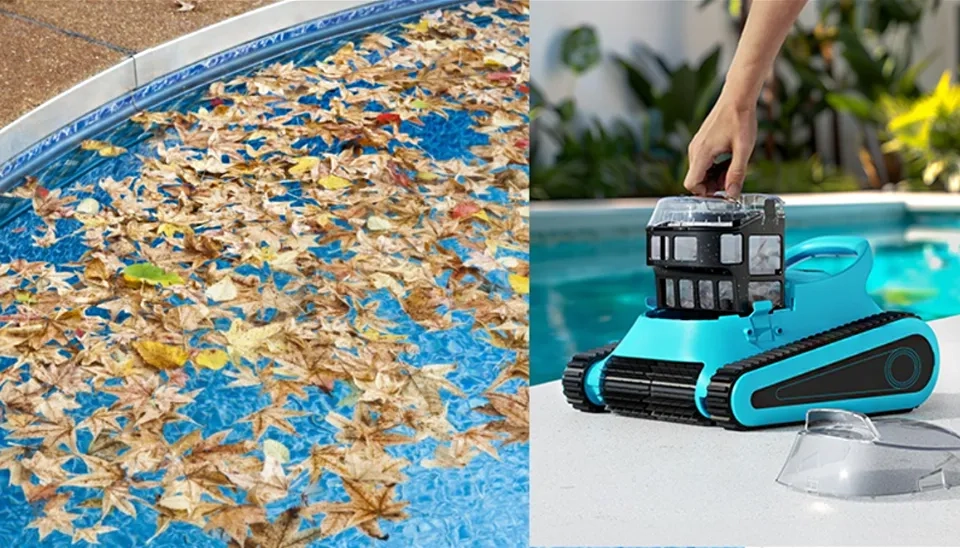
Pool water lines are where the water interacts with the side walls. This area is prone to algae and other contamination such as scum lines. Not all robotic pool vacuum cleaners have the ability to clean these regions. Therefore, if you want to clean these regions, consider buying a cleaner to have this feature. Another important consideration, especially if you want to run the cleaners at night, is the noise level. Quiet models have sounds around 50 to 60 decibels, while others can be higher than the number, which is similar to how the cleaner is working in doors. This can be considered if the pool is near residential areas.
3.2. Set Your Budget
The robotic pool vacuum cleaners’ price is one of the elements that should be considered. The price can vary significantly based on elements like motor power, wall climbing, connectivity, and brand. By determining the budget, you can narrow down your options. Robotic pool vacuum cleaners can have a wide price range from below $200 for small pools to higher than $1000 for large-scale use. The more advanced model comes with features such as wall climbing, wireless connectivity, multi-filtration, and long-term reliability. Establishing a clear budget should include not only the initial product cost but also installation, potential maintenance, and battery replacement fees if the device isn’t directly powered.
4. Mistakes to Avoid When Choosing a Robotic Pool Vacuum Cleaner
There are several key points that customers need to know to avoid mistakes when choosing a robotic pool vacuum cleaner. The first mistake to avoid is not considering the area and shape of your pool. The robotic pool vacuum cleaners are designed for a specific area, so it is necessary to consider your pool area. Also, simple cleaners might not have a good performance of irregularly shaped pools, so if your pools are not triangular, consider this fact. Also, robotic pool vacuum cleaners are designed for specific pool surfaces, such as concrete, vinyl, fibreglass, or tile. Make sure to select a cleaner that is best suited to your pool; otherwise, the pool’s surface might be damaged. Overlooking filter type and capacity is another mistake to avoid. You must identify the most common debris in your pool and select the best cleaner that matches. For example, if your pool is under the trees, the cleaners with carriage filters are not suitable for you. Moreover, consider the battery capacity as well to match the cleaning cycle needed for your pool. This ensures that robotic pool vacuum cleaners can complete the job without interruption. If the connectivity of the cleaner to the phone for remote monitoring and scheduling is important for you, consider selecting the smart cleaners. The last element to avoid is not considering the warranty time because robotic pool vacuum cleaners are relatively complex products with a variety of different parts. If one of them malfunctions, the cleaners do not work. Try to select a product with an extended warranty and a well-extended return period window.
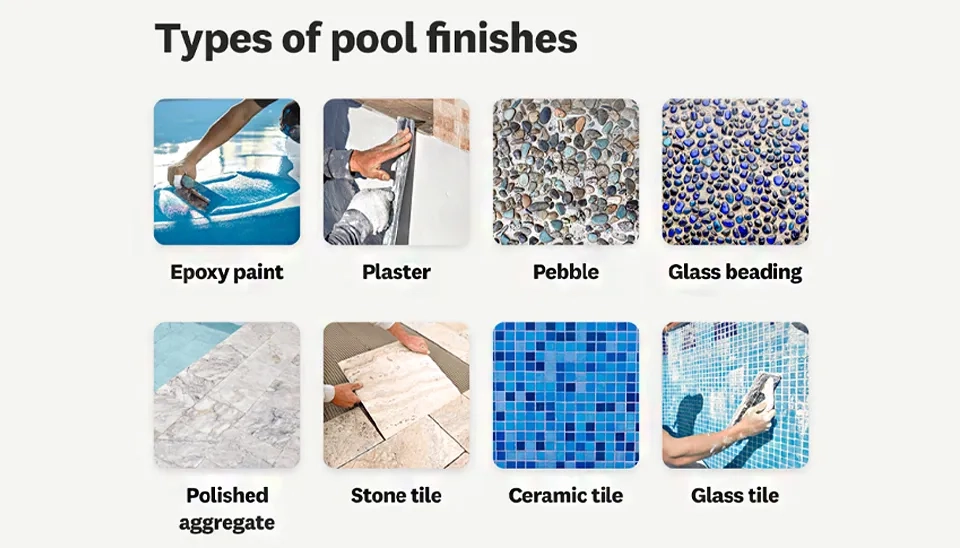
5. Checklist for Choosing the Best Robotic Pool Vacuum Cleaner
Have you identified your pool shape type? (e.g., rectangular, triangular, etc.)
Have you identified your pool surface material? (e.g., tile, concrete, fiberglass, etc.)
Have you identified your pool's main debris? (e.g. leaves, twigs, dust, etc.)
Does the robotic pool vacuum cleaner provide the technological features you need? (Consider connectivity, such as Wi-Fi or Bluetooth connection, and how they integrate with smart home systems)
Is the display and interface easy to use and simple to read? (e.g., LCD screens or LED indicators, or a touchscreen that shows real-time data)
Do you need a robotic pool vacuum cleaner with the ability to wall climb and clean water lines?
Have you considered your pool’s surface material?
Have you considered the pool area and ensured that the robotic pool vacuum cleaner can handle the size of your pool efficiently?
Does the cost correlate with your budget while maintaining the overall requirements and keeping the right balance between expense, features, and durability over time?
Have you looked into the customer service and availability options? (e.g., warranty, professional assistance, return policy, rapid delivery, packaging, free monitoring service, and responsiveness)
Are the materials durable and aligned with the environment in which you intend to use the products? (Extreme temperatures, as well as durable materials.)
Have you considered cleaning cycles? (ranging from below 2 hours to higher than 5 hours)?
Does the meter you select require installation, initial setup or maintenance needs?
Have you chosen the appropriate power source for your pool? (e.g., battery-based or wire-based)
Have you searched product rankings and reviews to ensure reliability? (e.g., Bayesian Rank, buying guide, reviews, comments, etc.)
6. Where to Buy a Robotic Pool Vacuum Cleaner
Presently, various companies offer robotic pool vacuum cleaners. To maximize your experience, try to select a popular company in this area. Companies like WYBOT, Polaris, CoasTeering, Dolphin, Vimily and BUBLUE are well known on the market, offering a wide range of products from simple robotic pool vacuum cleaners to advanced and smart ones. It is advisable to buy from these companies since they are reputable in these fields with producing different products. For buying from them, you can use online platforms like Amazon and Walmart. Amazon stands out as a trustworthy option, offering everything from affordable models to large-scale industrial units. Users can compare features, ratings, and read practical reviews to identify any flaws or malfunctions. With secure purchasing, fast shipping, and reliable customer service, Amazon has a global reach, though it primarily ships from the USA. Walmart also offers robotic pool vacuum cleaners and similar features, but has a smaller selection and physical stores in the USA and Canada. Alibaba caters to retailers seeking bulk purchasing options for multiple units. Some companies offer robotic pool vacuum cleaners on their website, providing products directly from the manufacturer.
7. Conclusion
This buying guideline offers a comprehensive guide for buying robotic pool vacuum cleaners, encompassing key features like power source, different technologies, smart features, material and durability, and filters. This guideline is suitable for homeowners who want to select the best robotic pool vacuum cleaner for their needs. This buying guide supports many different types of robotic pool vacuum cleaners, including wire-based, which is suitable for small pools with simple shapes; they are cheap and do not need batteries. Also, chargeable batteries that are more advanced and might offer Wi-Fi or Bluetooth connection, making them ideal for remote monitoring. This buying guide also provides online platforms for you to consider for buying robotic pool vacuum cleaners. We have also devoted a section to help users avoid any common mistakes when buying robotic pool vacuum cleaners. At the end, this buying guideline provided a checklist that individuals can use before buying robotic pool vacuum cleaners to make sure to consider every single detail, optimizing their selection. With this extensive buying guide of robotic pool vacuum cleaners, users can select a device that not only meets their needs but also adapts to future requirements, ensuring efficient water quality and potentially saving on maintenance and costs.
